


|
In Figure 1 we have started the program. The calculator has placed the ship and it has asked
for our guess. In this case we have guessed the point (5,5). Once we press the
 key to accept the y-coordinate, we will move to Figure 2. key to accept the y-coordinate, we will move to Figure 2.
|

| The calculator reports that we have missed the battleship by about 4.2426 units. That
means that the ship is on a circle with center at (5,5) and radius 4.2426. We have graphed such a circle below.
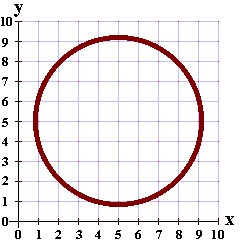 |

| In Figure 3 we have chosen our second guess as the point (9,5).
This time we are off by about 3.162 units. Therefore, we have drawn part of a
second circle below, this one with center at (9,5) and with a radius
3.162.
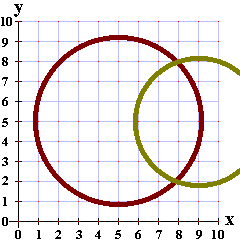 |

| Our next guess, as shown in Figure 3, is (8,2) and we were lucky enough to
get hit. The calculator is ready for a new game. |

| Again, we guess the point (5,5). This time we are off by approximately 4.4721 units. |

|
We have drawn a circle with center at our guess, (5,5) and with radius 4.4721.
From this we can see that there are a number of possible locations for the battleship.
We can also see that the point (9,5) is not a possible solution.
However, if we guess (9,5) we will get the distance from (9,5)
to the battleship.
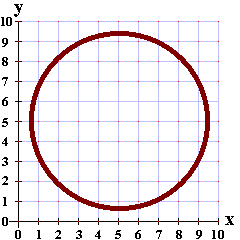 |

|
In Figure 7 we have made the guess at (9,5) and we find that
the distance from (9,5) to the battleship is about 7.2111.
Therefore we can draw part of the circle with center at (9,5)
and having a radius of about 7.2111. The new graph is given as:
 |

|
Unfortunately, the person playing this game decided to try the point (2,5).
Fromn Figure 8 we note that (2,5) misses the ship by 4.123 units.
Therefore, we can graph part of the circle with center at (2,5)
and radius equal to 4.123.
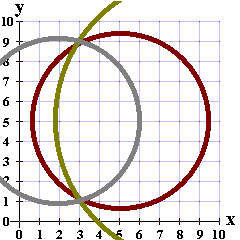 |

| Still not believing the graph, the player has guessed (3,5) only to discove that they have missed the ship by 4 units. |

| Finally, we arrive at a guess of (3,9). Luckily the ship has been hit. Please note that with the information that we had, it was just as likely that the ship was at (3,1). |

| Our player seems to have been tired of the game.
To get out of the game we press the
 key. This will bring up the
screen shown in Figure 11. We want the first option, Quit.
Therefore, press key. This will bring up the
screen shown in Figure 11. We want the first option, Quit.
Therefore, press  to select that highlighted option. to select that highlighted option.
|
The process shown above works quite well. It has the disadvantage of
finding many possible solutions. We can develop a different approach
that will cut down the number of possible solutions. We will do this by
making our guesses at the two lower corners of the playing field,
namely at

| In Figure 12 we have started the game again. |

|
Having guessed (0,0) and finding out that we missed the
battleship by 7.28 units, we can draw an arc on the graph with center at (0,0) and radius equal to 7.28
units.
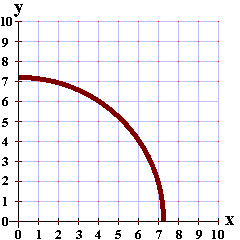 |

|
The next guess, (10,0), misses the ship by 10.63 units. Again we
can draw an arc covering all possible locations for the ship.
 |

| Our observation is confirmed in Figure 15. |
Figures 13 through 15 demonstrate the advantage of guessing at the lower left and lower right corners of the playing area. However, we are left with the need to draw the two arcs in order to make our final guess. We would like to find some way to determine the location of the ship without having to use a drawing.
The image below represents a guess at the point (0,0) with the result of missing the ship by r units.

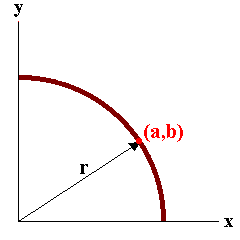
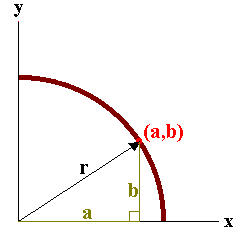

| We start the game and make our initial guess at (0,0). | ||||||||||||||||||||||||

| We are off by approximately 9.4868 units. This is the value of r.
We can compute (on another calculator) the value of r2
and we find that
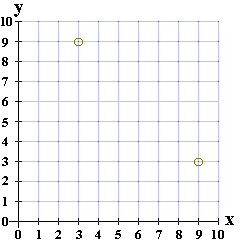 | ||||||||||||||||||||||||

| In Figure 10 we have the second guess, this one at (10,0). This guess is off
by about 3.162 units. Remember that our two
possible points are (3,9) and (9,3). The first point is too far away from
the guess at (10,0). The second point, (9,3), could certainly be about 3.162 units from (10,0).
We can construct a right triangle as shown below.
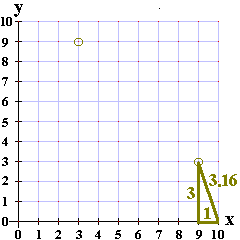 | ||||||||||||||||||||||||

| In Figure 19 we have guessed the point (9,3) and we have hit the ship at that location. | ||||||||||||||||||||||||

| We start another game in Figure 20. This time, our guess of (0,0) missed the
ship by about 5.83095 units. 5.830952 is about 33.9999779. Therefore,
we know that we are looking at triangle where the square of the hypotenuse (the side opposite
the right angle) is 34. We need to find two perfect squares from the table
| ||||||||||||||||||||||||

| Now we guess the point (10,0), only to find that we have missed the ship by about 8.6023 units. 8.60232 is about 73.99956, which we round off to 74. If we look at the table of squares, we see that 74=25+49. Therefore, the triangle from (10,0) to the location of the ship and then down to the x-axis must have sides of 5 and 7 units. Starting from (10,0) we can come back 5 units and go up 7 to get to the point (5,7). That point is the right distance from (10,0) but it was not one of the points we found before. The other alternative, starting at (10,0), going back 7 units on the x-axis and then moving up 5 units, puts us at the point (3,5), which was one of the possible locations. Therefore, we are certain that the ship is at the point (3,5). | ||||||||||||||||||||||||

| Figure 22 confirms our computations. | ||||||||||||||||||||||||

| Figure 23 starts a final example. Again we start with a guess of (0,0).
This time we missed the ship by about 8.0623 units. We find that 8.06232
is about 65.0007, which we round off to 65. We are looking for pairs of values
in the table of squares that add to give 65. In this case there are two such answers.
We have
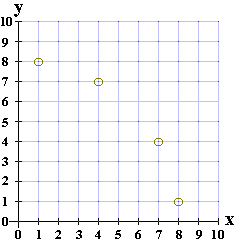 | ||||||||||||||||||||||||

| Our second guess, at (10,0), is off by about 9.2195. We compute
9.21952 to be about 84.99918, which we round to 85. The perfect squares that
add to 85 are 81+4 and 49+36. This means that the triangle from (10,0) to the ship and then
down to the x-axis will have sides of length 8 and 2, or sides of length 7 and 6.
Using the lengths 8 and 2, and starting from (10,0), we can move back 8 and up 2 to get to the point (2,2),
or we can move back 2 and up 8 to get to the point (8,8), but neither
point is one of our possible points.
on the other hand, if we use lengths 7 and 6, starting at (10,0) we can move back 7 and up 6 to
get to the point (3,6) or we can move back 6 and up 7 to get to the point (4,7).
 | ||||||||||||||||||||||||

| Figure 25 confirms our computations. |
A slightly more difficult version of this program places the ship into a playing field that contains portions of all four quadrants. The bat2f page describes and demonstrates solutions for this alternate version.
©Roger M. Palay
Saline, MI 48176
May, 2001